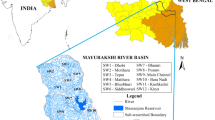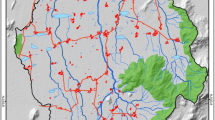Abstract
A micro-watershed is the smallest hydrological unit with a unique type of common-pool resource, defined by hydrological linkages and requiring coordinated use of natural resources by all users for optimal management. However, the watersheds in the central Himalayan region are particularly vulnerable to land degradation since they are subject to various fluvial and denudation processes. As a result, the present study focused on the Bacchanshiv Gad watershed in the subtropical zone, where soil erosion is more prevalent due to various hydro-geomorphological causes. The analysis considered fourteen different areal, linear, shape, and landscape morphometric parameters by integrating spatial and compromise statistical programming techniques to prioritize 8 micro-watersheds. Moreover, the study gives comprehensive insight about the current land use land cover spatial distribution, lithological and pedan characteristics of the watershed that play a significant role in taking appropriate land and water conservation measures to prevent further soil degradation.
Similar content being viewed by others
References
Akgun, A. (2012) A comparison of landslide susceptibility maps produced by logistic regression, multi-criteria decision, and likelihood ratio methods: a case study at Izmir, Turkey. Landslides, v.9(1), pp.93–106.
Altaf, S., Meraj, G. and Romshoo, S. A. (2014) Morphometry and land cover based multi-criteria analysis for assessing the soil erosion susceptibility of the western Himalayan watershed. Environ. Monit. Assess., v.186(12), pp.8391–8412.
Ameri, A. A., Pourghasemi, H. R. and Cerda, A. (2018) Erodibility prioritization of sub-watersheds using morphometric parameters analysis and its mapping: A comparison among TOPSIS, VIKOR, SAW, and CF multi-criteria decision making models. Sci. Total Environ., v.613, pp.1385–1400.
Arabameri, A., Pradhan, B., Pourghasemi, H.R. and Rezaei, K. (2018). Identification of erosion-prone areas using different multi-criteria decision-making techniques and GIS. Geomatics, Natural Hazards and Risk, v.9(1), pp.1129–1155.
Batar, A.K., Watanabe, T. and Kumar, A. (2017) Assessment of Land-Use/Land-Cover Change and Forest Fragmentation in the Garhwal Himalayan Region of India. pp.1–16. doi:https://doi.org/10.3390/environments4020034
Biswas, S., Sudhakar, S., and Desai, V.R. (1999) Prioritisation of Subwatersheds Based on Morphometric Analysis of drainage basin: A remote senseing and GIS approach. Jour. Indian Soc. Remote Sens., v.27, pp.155–166.
Chandniha, S.K. and Kansal, M.L. (2017) Prioritization of sub-watersheds based on morphometric analysis using geospatial technique in Piperiya watershed, India. Appl. Water Sci., v.7(1), pp.329–338.
Chauhan, P., Chauniyal, D.D., Singh, N. and Tiwari, R.K. (2016) Quantitative geo-morphometric and land cover-based micro-watershed prioritization in the Tons river basin of the lesser Himalaya. Environ. Earth Sci., v.75(6), pp.1–17.
Chauniyal, D.D. (2018) Evidences of Neo-Tectonic Landforms between Srinagar and Bagwan Area in Lower Alaknanda Valley (Garhwal Himalaya), India. In: Conference of the Arabian Jour. Geosci. Springer, Cham., pp.323–326.
Chowdhury, B., Goel, N.K. and Arora, M. (2021) Evaluation and ranking of different gridded precipitation datasets for Satluj River basin using compromise programming and f-TOPSIS. Theoretical and Applied Climatology, v.143(1), pp.101–114.
Diaz-Balteiro, L., Voces González, R. and Romero, C. (2011) Making sustainability rankings using compromise programming. An application to European paper industry. Silva Fennica, v.45(4), pp.761–773.
Fallah, M., Kavian, A. and Omidvar, E. (2016) Watershed prioritization in order to implement soil and water conservation practices. Environ. Earth Sci., v.75(18), 1248.
Funk, A., Martínez-López, J., Borgwardt, F., Trauner, D., Bagstad, K. J., Balbi, S., Magrach, A., Villa, F., & Hein, T. (2019). Identification of conservation and restoration priority areas in the Danube River based on the multi-functionality of river-floodplain systems. Sci. Total Environ., v.654, pp.763–777.
Gera, M., Sankhayan, P.L. and Hofstad, O. (2010) A systems approach for analyzing vegetative and soil degradation in Arnigad micro-watershed of Indian Himalayan region. Jour. Mount. Sci., v.7(4), pp.315–326.
Gomez-Gutie’rrez, A., Conoscenti, C., Angileri, S.E., Rotigliano, E., Schnabel, S. (2015) Using topographical attributes to evaluate gully erosion proneness (susceptibility) in two mediterranean basins: advantages and limitations. Natural Hazards, v.79(1), pp.291–314.
Gravelius, H. (1914). Grundriss der gesamten Gewässerkunde.
GJ Göschen. Kadam, A., Karnewar, A.S., Umrikar, B. and Sankhua, R.N. (2019) Hydrological response-based watershed prioritization in semiarid, basaltic region of western India using frequency ratio, fuzzy logic and AHP method. Environ. Develop. Sustain., v.21(4), pp.1809–1833.
Khare, D., Mondal, A., Kundu, S. and Mishra, P.K. (2017) Climate change impact on soil erosion in the Kalsa River Basin, North India. Appl. Water Sci., v.7(5), pp.2373–2383.
Kumar, A., Chaudhary, S. and Negi, M.S. (2019). A study of spatio-temporal landuse/land cover change dynamics in Rudraprayag District, (Garhwal Himalaya) using remote sensing and GIS. Jour. Global Resour., v.5, pp.61–69.
Kumar, A., Singh, S., Pramanik, M., Chaudhary, S., Maurya, A. K. and Kumar, M. (2021) Watershed prioritization for soil erosion mapping in the Lesser Himalayan Indian basin using PCA and WSA methods in conjunction with morphometric parameters and GIS-based approach. Environ., Develop. Sustain, v.24, pp. 3723–3761.
Li, M., Cao, X., Liu, D., Fu, Q., Li, T. and Shang, R. (2022) Sustainable management of agricultural water and land resources under changing climate and socio-economic conditions: A multi-dimensional optimization approach. Agricul. Water Managmt., v.259, 107235.
Malik, A., Kumar, A. and Kandpal, H. (2019) Morphometric analysis and prioritization of sub-watersheds in a hilly watershed using weighted sum approach. Arabian Jour. Geosci., v.12(4), pp.118.
Montgomery, D.R. and Dietrich, W.E. (1992). Channel Initiation and the Problem of Landscape Scale. Science, v.255(5046), 826 LP - 830.
Moore, I.D. and Burch, G.J. (1986) Modelling erosion and deposition: topographic effects. Trans. ASAE, v.29(6), pp.1624–1630.
Moore, I.D. and Grayson, R.B. (1991) Terrain? based catchment partitioning and runoff prediction using vector elevation data. Water Resour. Res., v.27(6), pp.1177–1191.
Moore, I.D., Gessler, P.E., Nielsen, G.A.E., and Peterson, G.A. (1993) Soil attribute prediction using terrain analysis. Soil Sci. Soc. Amer. Jour., v.57(2), pp.443–452.
Nefeslioglu, H.A., Gokceoglu, C. and Sonmez, H. (2008) An assessment on the use of logistic regression and artificial neural networks with different sampling strategies for the preparation of landslide susceptibility maps. Engg. Geol., v.97(3–4), pp.171–191.
Nitheshnirmal, S., Bhardwaj, A., Dineshkumar, C. and Rahaman, S.A. (2019) Prioritization of Erosion Prone Micro-Watersheds Using Morphometric Analysis coupled with Multi-Criteria Decision Making. Multidisciplinary Digital Publishing Institute proceedings, v.24(1), pp.11.
Nunchhani, V., Golom, T., Nirin, L., Bandyopadhyay, A. and Bhadra, A. (2020) Prioritization of Mago Basin based on erodibility through morphometric analysis using GIS technique: A PCA-based approach. Jour. Soil and Water Conserv., v.19(1), pp.10–16.
Rahmati, O., Pourghasemi, H.R., Melesse, A. (2016) Application of GIS-based data driven random forest and maximum entropy models for groundwater potential mapping: a case study at Mehran Region, Iran. Catena, v.137:, pp.360–372
Rahmati, O., Samadi, M., Shahabi, H., Azareh, A., Rafiei-Sardooi, E., Alilou, H., Melesse, A. M., Pradhan, B., Chapi, K. and Shirzadi, A. (2019) SWPT: An automated GIS-based tool for prioritization of sub-watersheds based on morphometric and topo-hydrological factors. Geosci. Front., v.10(6), pp.2167–2175.
Raju, K.S., Nagesh Kumar, D. (2014) Multicriterion analysis in engineering and management. Prentice Hall of India, New Delhi
Rana, N., Singh, S., Sundriyal, Y.P., Rawat, G. S. and Juyal, N. (2016). Interpreting the geomorphometric indices for neotectonic implications: An example of Alaknanda valley, Garhwal Himalaya, India. Jour.f Earth Syst. Sci., v.125(4), pp.841–854.
Rao, K.S. and Pant, R. (2001) Land use dynamics and landscape change pattern in a typical micro watershed in the mid elevation zone of central Himalaya, India. Agricul., Ecosyst. Environ., v.86(2), pp.113–124.
Sarkar, D., Gangopadhyay, S.K. and Sahoo, A.K. (2006) Soil resource appraisal towards land use planning using satellite remote sensing and gis a case study in patloinala micro-watershed, district Puruliya, West Bengal. Jour. Indian Soc. Remote Sensing, v.34(3), pp.245.
Sharma, S. and Mahajan, A.K. (2020) GIS-based sub-watershed prioritization through morphometric analysis in the outer Himalayan region of India. Appl. Water Sci., v.10(7), pp.163.
Siddiqui, R., Said, S. and Shakeel, M. (2020) Nagmati River Sub-watershed Prioritization Using PCA Integrated PCWS and AHP?: A Case Study. Natural Resour. Res., v.29, pp.2411–2430.
Singh, O. and Singh, J. (2018) Soil Erosion Susceptibility Assessment of the Lower Himachal Himalayan Watershed. Jour. Geol. Soc. India, v.92(2), pp.157–165
Smith, K.G. (1950) Standards for grading texture of erosional topography. Amer. Jour. Sci., v.248, pp.655–668
Srinivasa Raju, K., Sonali, P. and Nagesh Kumar, D. (2017). Ranking of CMIP5-based global climate models for India using compromise programming. Theoretical and Applied Climatology, v.128(3–4), pp.563–574.
Tahmassebipoor, N., Rahmati, O., Noormohamadi, F., Lee, S. (2016) Spatial analysis of groundwater potential using weights-of-evidence and evidential belief function models and remote sensing. Arab. Jour. Geosci., v.9, pp.1–18.
Wakeel, A., Rao, K.S., Maikhuri, R.K. and Saxena, K.G. (2005) Forest management and land use/cover changes in a typical micro watershed in the mid elevation zone of Central Himalaya, India. Forest Ecol. Managmt., v.213(1), pp.229–242.
Whipple, K.X. and Tucker, G.E. (1999). Dynamics of the stream-power river incision model: Implications for height limits of mountain ranges, landscape response timescales, and research needs. Jour. Geophys. Res.: Solid Earth, v.104(B8), pp.17661–17674.
Yadav, S.K., Dubey, A., Szilard, S. and Singh, S.K. (2018) Prioritisation of sub-watersheds based on earth observation data of agricultural dominated northern river basin of India. Geocarto Internat., v.33(4), pp.339–356.
Yadav, S.K., Singh, S.K., Gupta, M. and Srivastava, P.K. (2014) Morphometric analysis of Upper Tons basin from Northern Foreland of Peninsular India using CARTOSAT satellite and GIS. Geocarto Internat., v.29(8), pp.895–914
Zeleny, M., and Cochrane, J.L. (1982) Multiple criteria decision making McGraw-Hill New York, 34p.
Author information
Authors and Affiliations
Corresponding author
Electronic Supplementary Material
12594_2023_2365_MOESM1_ESM.pdf
Supplementary material for the article “Micro-watershed Planning using Prioritisation Approach Integrated with Geospatial Techniques and Compromise Programming: A Case Study of Bacchanshiv Gad (Alaknanda River), India” by Atul Kumar, Neha Chauhan, Sonu Kumar, Upendra Bhai Patel and Malay Pramanik. Jour. Geol. Soc. India, v.99, 2023, pp.647–656
Rights and permissions
About this article
Cite this article
Kumar, A., Chauhan, N., Kumar, S. et al. Micro-watershed Planning using Prioritisation Approach Integrated with Geospatial Techniques and Compromise Programming: A Case Study of Bacchanshiv Gad (Alaknanda River), India. J Geol Soc India 99, 647–656 (2023). https://doi.org/10.1007/s12594-023-2365-2
Received:
Accepted:
Published:
Issue Date:
DOI: https://doi.org/10.1007/s12594-023-2365-2




